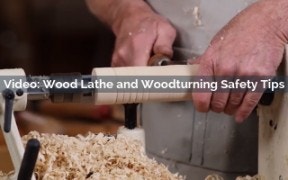Wood Lathe & Woodturning Safety Tips

Learn these tips for using a woodworking lathe safely. What safety gear do you need to use a lathe?
Skill Builder Video
Wood Lathe and Woodturning Safety Tips - Video Transcript
Speaker 1: Another appealing aspect of wood turning this that it's relatively safe. There are a few very avoidable dangers which we'd like to bring to your attention. Like any other aspect of woodworking, there is some basic safety such as clothing.
Speaker 2: When you go into the woodshop, you usually think about what you're wearing. With turning in particular, you want to be very aware of anything that might be dangling down. You don't want to wear long earrings, you want to make sure any long hair is pulled back and is going to stay there. No dangly bracelets, no dangly watches, rings. The other thing that you want to think about is your sleeves. You don't want to wear long sleeves that could potentially get caught in the lathe. Short sleeves are a good idea or go ahead and roll up your long sleeves. Another thing to think about as far as your clothing is your shoes. You absolutely want to wear closed-toed shoes to protect your feet.
Speaker 1: Glasses, eyeglasses should conform to the American National Safety Institute standards. These are polycarbonate lenses with deep channels in the frame that prevent them from popping out and also side shields for side protection, so that the chips can't come around the corner. Even with all of that, if I'm turning something really big and nasty like a big bowl with a lot of bark inclusion on it, I'm going to wear a face shield over my safety glasses.
Speaker 2: With turning, you generally think of the chips coming off the lathe, which wouldn't necessarily be a problem when we're thinking about our respiratory health, but there is usually a sanding involved with turning, in which case you're going to want to wear a paper mask at a minimum to protect your lungs.
Speaker 1: Speed is very important and most turning accidents are from accidentally starting the lathe at too a high speed and the piece flying out of the lathe. Appropriate speeds for spindle turning are between 800 and 1800 RPMs for most normal size spindles. For miniatures, you can go about as fast as the lathe will go safely. For face plate work, you need to turn much slower. Anywhere down as low as 150 RPMs for big, out of balance bowls and a maximum of 1200 RPMs with no improvement in the quality of the cut for going faster, so it's senseless to go faster than that.
Very important is the tool rest. When you for start the lathe, you want to make sure that this doesn't hit the tool rest. We want to come over here, we each got to get out of the way, out of this danger zone.
Speaker 2: The danger zone is behind the lathe, directly behind the piece or directly in front of the piece. If there is somebody else in your shop, you probably want to let them know you're about to start the lathe so that they are aware too.
Speaker 1: I've set the speed as low as it will go, I've turned the lathe on and I now bring that speed up gradually to something appropriate. I'm going about 1000 RPM, it's appropriate for this spindle.
Speaker 2: Another consideration when you're in your shop is lighting. You want to be sure that you can see what you're working on. It makes it much easier. The last thing that we want to mention is when you're in the shop you want to use common sense. If something doesn't feel right, you're probably correct in your thinking and you want to go ahead and turn the machine off and re-evaluate the situation.
Keep the inspiration coming!
Subscribe to our newsletter for more woodworking tips and tricks

